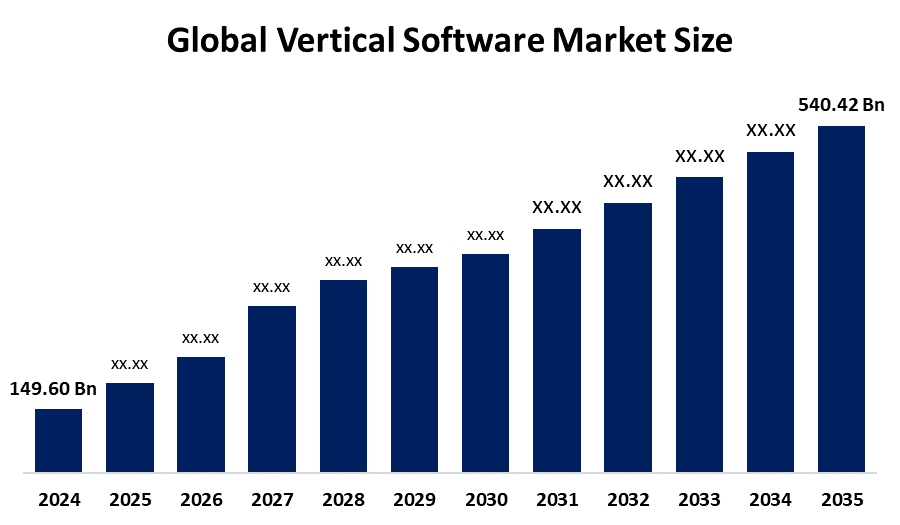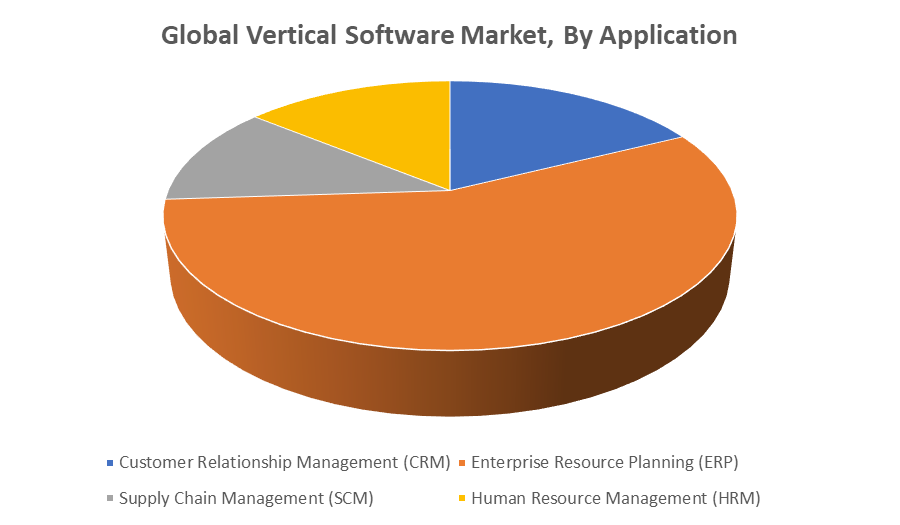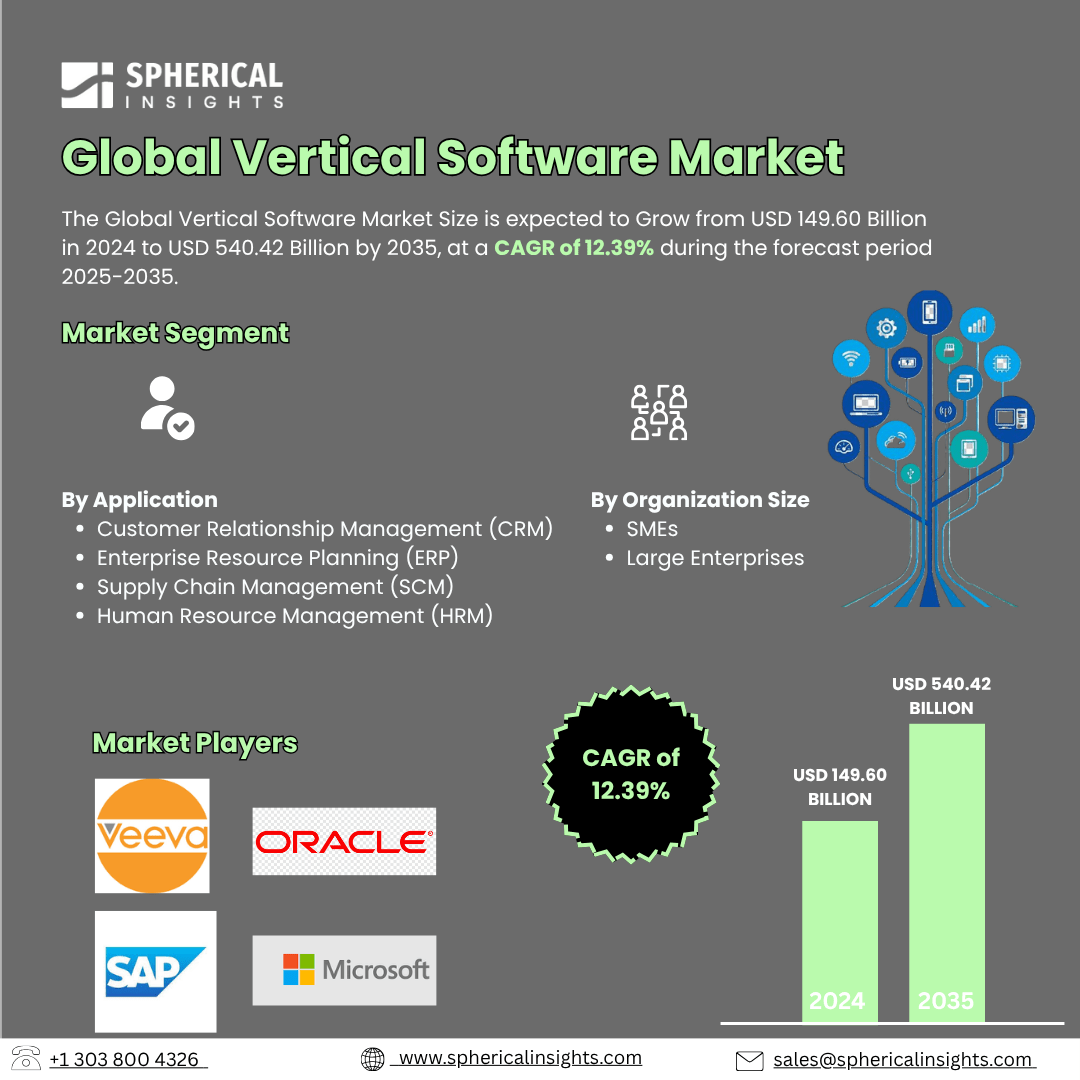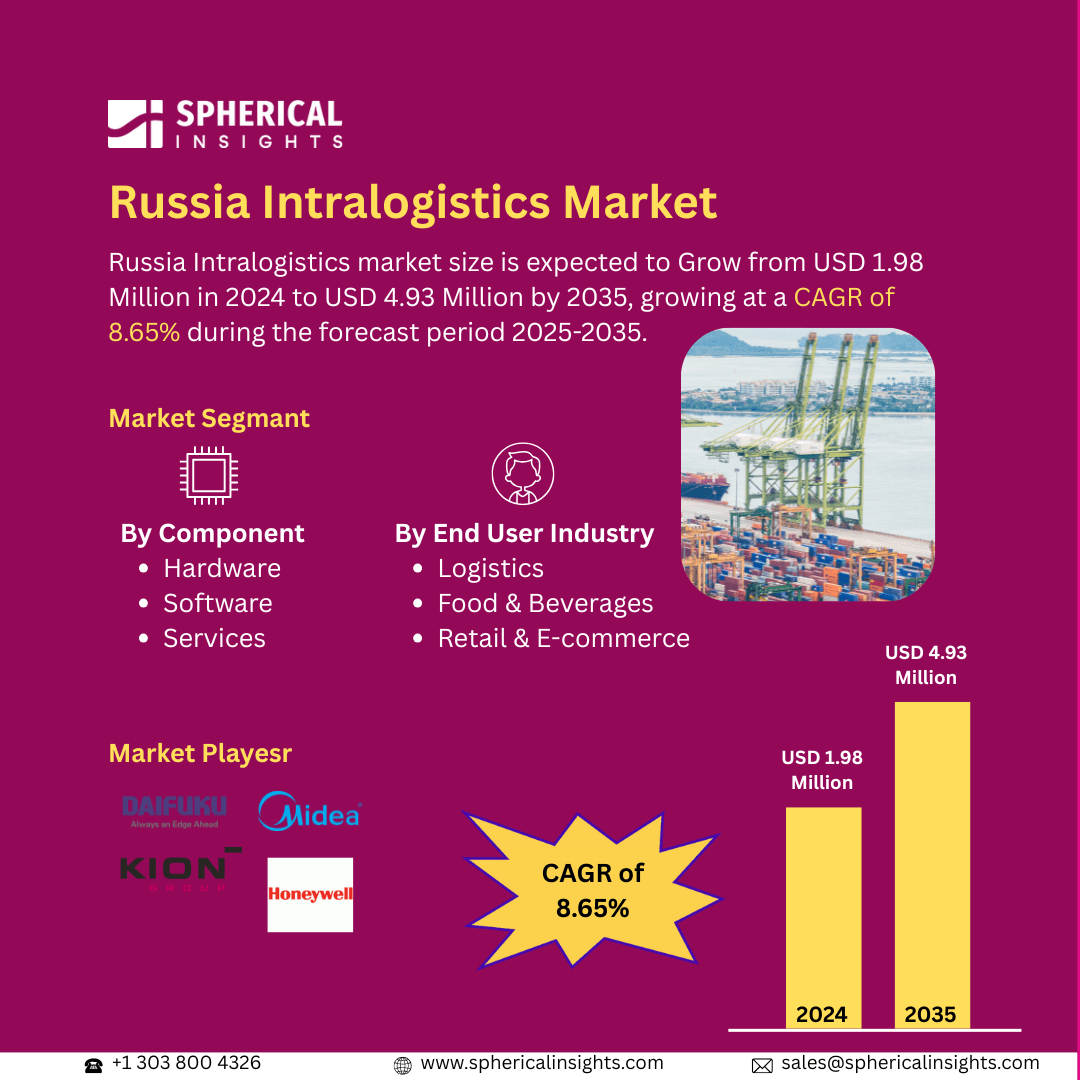Global Vertical Software Market Insights Forecasts to 2035
- The Global Vertical Software Market Size Was Estimated at USD 149.60 Billion in 2024
- The Market Size is Expected to Grow at a CAGR of around 12.39% from 2025 to 2035
- The Worldwide Vertical Software Market Size is Expected to Reach USD 540.42 Billion by 2035
- Asia Pacific is expected to grow the fastest during the forecast period.

Vertical Software Market
The Global Vertical Software Market Size refers to software solutions tailored for specific industries such as healthcare, finance, manufacturing, or retail. Unlike horizontal software that serves general business needs, vertical software addresses specialized workflows, compliance requirements, and operational challenges within particular sectors. The market has witnessed rapid growth due to increasing digital transformation, demand for efficiency, and industry-specific regulations. Governments worldwide are actively promoting digital adoption through initiatives like the U.S. Digital Government Strategy, India’s Digital India campaign, and Europe’s Digital Decade, driving demand for vertical software. These programs often include incentives for businesses to modernize operations using tech solutions tailored to their industry. Cloud-based deployment, AI integration, and customizable solutions are key trends shaping the market. As industries become more complex and data-driven, vertical software is playing a critical role in enhancing productivity, ensuring regulatory compliance, and enabling innovation, thereby fueling the market’s steady expansion across both developed and emerging economies.
Attractive Opportunities in the Vertical Software Market
- The rise of AI, machine learning, and Internet of Things (IoT) technologies enables the development of more intelligent, data-driven vertical software solutions tailored for specific industry needs. These innovations allow businesses to automate processes, gain predictive insights, and enhance operational efficiency, opening new avenues for software providers to offer cutting-edge, customized products.
- Emerging economies like China, India, and Southeast Asia are experiencing fast-paced digital transformation, supported by government initiatives promoting smart manufacturing, healthcare digitization, and e-governance. This creates a vast, underserved market with increasing demand for tailored vertical software solutions, especially among the growing number of SMEs investing in digital tools.
- The shift towards cloud computing and mobile platforms offers scalable, flexible, and cost-effective deployment options. Cloud-based vertical software solutions enable organizations to quickly adapt to evolving industry requirements, access real-time data, and support remote workforces, making this a highly attractive growth area for software developers and vendors.
Global Vertical Software Market Dynamics
DRIVER: Rapid adoption of cloud computing allows for scalable
Increasing industry-specific digital transformation demands tailored solutions that enhance operational efficiency and compliance. Rapid adoption of cloud computing allows for scalable, cost-effective deployment. Rising regulatory requirements in sectors like healthcare and finance fuel demand for software that ensures compliance. Technological advancements, such as AI, IoT, and big data analytics, are enhancing software capabilities. Additionally, government initiatives promoting digitalization across industries, especially in emerging economies, are accelerating adoption. The growing need for real-time data, automation, and improved customer experiences further contributes to the market’s robust expansion.
RESTRAINT: Data privacy and cybersecurity concerns
High initial costs and long implementation timelines can deter small and medium-sized enterprises. Customization requirements for different industries often lead to complex and resource-intensive development processes. Integration with existing legacy systems poses technical challenges and increases operational risks. Data privacy and cybersecurity concerns, especially in sectors handling sensitive information like healthcare and finance, further limit adoption. Additionally, a shortage of skilled professionals to implement and maintain specialized software can slow down deployment. Market fragmentation and rapidly evolving regulatory standards also create barriers for consistent and scalable growth across regions.
OPPORTUNITY: Technological innovation and evolving industry needs
The global vertical software market presents significant growth opportunities driven by technological innovation and evolving industry needs. The rise of AI, machine learning, and IoT allows for the development of more intelligent, data-driven solutions tailored to specific sectors. Emerging markets, particularly in the Asia-Pacific, offer vast potential due to increasing digital adoption and supportive government initiatives. The growing demand for cloud-based and mobile-first solutions opens doors for scalable, flexible software offerings. Additionally, industries like healthcare, education, logistics, and finance are undergoing rapid digital transformation, creating new niches for vertical software. The shift toward personalized customer experiences and data-driven decision-making further boosts demand. Partnerships between tech providers and industry leaders also offer room for co-innovation, accelerating adoption and long-term market growth.
CHALLENGES: Integration with legacy systems remains complex and time-consuming
Integration with legacy systems remains complex and time-consuming. Rapidly changing industry regulations require constant software updates, increasing maintenance burdens. Data security and privacy concerns, especially in regulated sectors, pose significant risks. Additionally, a lack of skilled professionals with domain-specific knowledge hampers effective implementation. Market fragmentation and varying global standards further complicate scalability and consistent product delivery across regions.
Global Vertical Software Market Ecosystem Analysis
The global vertical software market ecosystem includes specialized vendors, tech giants like Microsoft and SAP, system integrators, and industry-specific end users. It thrives on tailored solutions for sectors like healthcare, finance, and manufacturing, supported by APIs, analytics, and cloud integration. Pure-play providers (e.g., Veeva) coexist with horizontal firms offering vertical overlays. Growth is driven by digital transformation, AI, IoT, and regulatory demands. North America leads in adoption, while Asia-Pacific shows rapid growth, creating dynamic, competitive, and innovation-driven market conditions.
Based on the application, the enterprise resource planning (ERP) segment accounted for the largest market revenue share in 2024.

The enterprise resource planning (ERP) segment dominance is attributed to ERP's critical role in streamlining core business processes such as finance, supply chain, human resources, and manufacturing within specific industries. ERP solutions offer tailored functionalities that help enterprises improve operational efficiency, ensure regulatory compliance, and enhance decision-making. The growing need for real-time data access, integration of cloud-based platforms, and industry-specific customizations further boosted ERP adoption, especially in sectors like manufacturing, healthcare, and retail.
Based on the organization size, the large enterprises segment accounted for the major revenue share during the forecast period
The large enterprises segment accounted for the major revenue share during the forecast period. This is due to their greater resources and complex operational needs that demand comprehensive, customized vertical software solutions. Large enterprises invest heavily in digital transformation to improve efficiency, compliance, and scalability across multiple departments and locations. Additionally, their ability to adopt advanced technologies like AI, IoT, and cloud integration accelerates vertical software implementation, driving significant market revenue compared to small and medium-sized businesses.
North America is anticipated to hold the largest market share of the vertical software market during the forecast period
North America is anticipated to hold the largest market share in the vertical software market during the forecast period. This dominance is driven by the region’s advanced technological infrastructure, high digital adoption rates, and the presence of numerous leading software vendors. Additionally, stringent regulatory requirements across industries like healthcare, finance, and manufacturing fuel demand for specialized software solutions. Strong government initiatives supporting digital transformation, along with a large base of enterprises investing in industry-specific software, further contribute to North America’s leading position in the market.
Asia Pacific is expected to grow at the fastest CAGR in the vertical software market during the forecast period
Asia Pacific is expected to grow at the fastest CAGR in the vertical software market during the forecast period. Rapid digital transformation, increasing technology adoption, and expanding industrialization in countries like China, India, and Southeast Asia drive this growth. Government initiatives promoting smart manufacturing, healthcare digitization, and e-governance further accelerate demand. Additionally, the rising number of small and medium enterprises investing in tailored software solutions, along with improvements in IT infrastructure, contribute to the region’s robust market expansion and its emergence as a key growth hub.
Recent Development
- In October 2024, Oracle introduced a new AI-powered software suite tailored specifically for the healthcare and retail sectors. This suite leverages artificial intelligence to streamline operations, automate routine tasks, and provide real-time insights. By addressing industry-specific challenges, it helps organizations improve efficiency, reduce errors, and enhance customer experiences. The AI capabilities enable smarter decision-making through data-driven analytics and predictive tools. This launch reflects Oracle’s commitment to delivering customized solutions that meet the evolving needs of key vertical markets.
Key Market Players
KEY PLAYERS IN THE VERTICAL SOFTWARE MARKET INCLUDE
- SAP SE
- Oracle Corporation
- Microsoft Corporation
- Veeva Systems
- Infor
- Epic Systems
- Cerner Corporation
- Total Specific Solutions (TSS)
- IFS AB
- Workday, Inc.
- Others
Market Segment
This study forecasts revenue at global, regional, and country levels from 2020 to 2035. Spherical Insights has segmented the vertical software market based on the below-mentioned segments:
Global Vertical Software Market, By Application
- Customer Relationship Management (CRM)
- Enterprise Resource Planning (ERP)
- Supply Chain Management (SCM)
- Human Resource Management (HRM)
Global Vertical Software Market, By Organization Size
Global Vertical Software Market, By Regional Analysis
- North America
- Europe
- Germany
- UK
- France
- Italy
- Spain
- Russia
- Rest of Europe
- Asia Pacific
- China
- Japan
- India
- South Korea
- Australia
- Rest of Asia Pacific
- South America
- Brazil
- Argentina
- Rest of South America
- Middle East & Africa
- UAE
- Saudi Arabia
- Qatar
- South Africa
- Rest of the Middle East & Africa





